
Rehovot is a city in the Central District of Israel, about 20 kilometers south of Tel Aviv. In 2022 it had a population of 150,748.
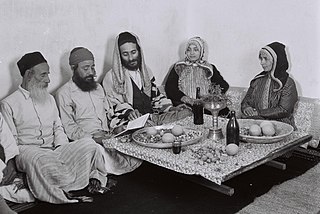
Yemenite Jews, also known as Yemeni Jews or Teimanim, are Jews who live, or once lived, in Yemen, and their descendants maintaining their customs. Between June 1949 and September 1950, the overwhelming majority of the country's Jewish population emigrated to Israel in Operation Magic Carpet. After several waves of persecution, the vast majority of Yemenite Jews now live in Israel, while smaller communities live in the United States and elsewhere. As of 2024, only five Jews remained in Yemen, with one of them being Levi Marhabi.
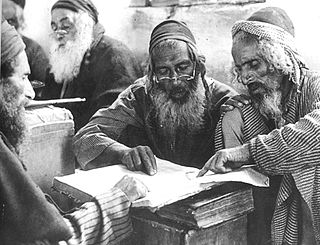
Yemenite Hebrew, also referred to as Temani Hebrew, is the pronunciation system for Hebrew traditionally used by Yemenite Jews. Yemenite Hebrew has been studied by language scholars, many of whom believe it retains older phonetic and grammatical features lost elsewhere. Yemenite speakers of Hebrew have garnered considerable praise from language purists because of their use of grammatical features from classical Hebrew.
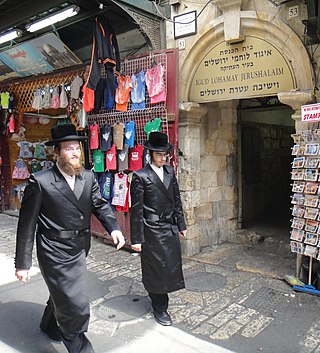
Ateret Cohanim, also Ateret Yerushalayim, is an Israeli Jewish organization with a yeshiva located in the Muslim Quarter of the Old City of Jerusalem. It supports the creation of a Jewish majority in the Old City and in Arab neighborhoods in East Jerusalem. Notable alumni of the yeshiva include Rabbi Nissan Ben-Avraham and Rabbi Eyal Karim.
The First Aliyah, also known as the agriculture Aliyah, was a major wave of Jewish immigration (aliyah) to Ottoman Palestine between 1881 and 1903. Jews who migrated in this wave came mostly from Eastern Europe and from Yemen, stimulated by pogroms and violence against the Jewish communities in those areas. An estimated 25,000 Jews immigrated. Many of the European Jewish immigrants during the late 19th-early 20th century period gave up after a few months and went back to their country of origin, often suffering from hunger and disease.

Shalom Shabazi was the son of Yosef ben Avigad, of the family of Mashtā, also commonly known as Abba Sholem Shabazi or Saalem al-Shabazi. He was a Jewish rabbi and poet who lived in 17th century Yemen, often referred to as the arch-poet of Yemen.

Silwan or Siloam is a predominantly Palestinian district in East Jerusalem, on the southeastern outskirts of the current Old City of Jerusalem.

Kokhav Ya'akov is a religious Israeli settlement organized as a community settlement in the West Bank. Located near the Palestinian town of al-Bireh, it is administered by Mateh Binyamin Regional Council. In 2022 it had a population of 9,794. The settlement is north of Jerusalem and close to the Palestinian city of Ramallah.

Abu Kabir was a satellite village of Jaffa founded by Egypt following Ibrahim Pasha's 1832 defeat of Turkish forces in Ottoman era Palestine. During the 1948 Palestine war, it was mostly abandoned and later destroyed. After Israel's establishment in 1948, the area became part of south Tel Aviv. Officially part of Giv'at Herzl, the adjacent Jewish neighborhood, the name Abu Kabir continued to be used. Part or all of Abu Kabir was officially renamed Tabitha by the Tel Aviv municipality in 2011.
Ir David Foundation or City of David Foundation, commonly known as Elad [El'ad], is a Jerusalem-based Israeli settler association which aims to strengthen the Jewish connection to Jerusalem, and renew the Jewish community in the City of David, which is also part of the neighborhood of Silwan. The foundation works to achieve its goals by tourism, education, archaeological excavations and obtaining homes in the area to establish a Jewish presence.
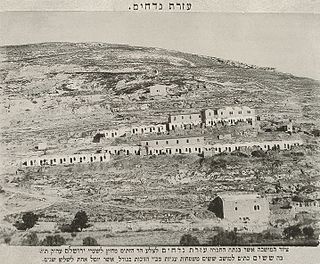
The Old Yemenite Synagogue, known to its congregation as Beit Knesset Ohel Shlomo, is a Jewish congregation and restored synagogue, located in the Silwan district of East Jerusalem. The synagogue was constructed in the nineteenth century in the Yemenite Village, in the Kfar Hashiloach neighborhood.
Beit Yonatan is an apartment building owned by Ateret Cohanim and located in the Silwan neighborhood just outside the Old City of Jerusalem. The building has been the subject of many issues and debates between Jews and Arabs in Israel.

Yiḥya Yitzḥak Halevi, son of Moshe (Musa) Yitzḥak Halevi, was a Yemeni born rabbinical scholar who served as one of the last great scholars and chief jurists of the rabbinic court at Ṣan‘ā’, which post he held for nearly thirty years, a time interrupted only during the siege laid to the city by loyal Yemeni forces under Imām Yaḥyā Ḥamīd ad-Dīn (1904—1948) in their bid to oust the Ottoman Turks who then controlled the city. The Rabbi, meanwhile, had fled with his family to Dhamar.
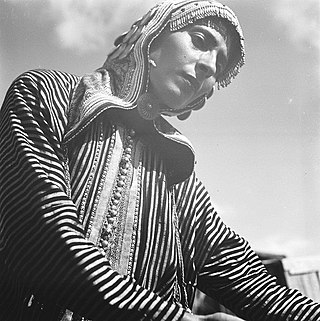
Yemenite Jews in Israel are immigrants and descendants of the immigrants of the Yemenite Jewish communities, who now reside within the state of Israel. They number around 400,000 in the wider definition. Between June 1949 and September 1950, the overwhelming majority of Yemen and Aden's Jewish population was transported to Israel in Operation Magic Carpet.

Avraham Al-Naddaf (1866–1940), the son of Ḥayim b. Salem Al-Naddaf, was a Yemenite rabbi and scholar who immigrated to Ottoman Palestine in 1891, eventually becoming one of the members of the Yemenite rabbinical court (Beit-Din) established in Jerusalem in 1908, and active in public affairs. His maternal grandfather was Rabbi Yiḥya Badiḥi (1803–1887), the renowned sage and author of the Questions & Responsa, Ḥen Ṭov, and a commentary on the laws of ritual slaughter of livestock, Leḥem Todah, who served as the head of Sanaa's largest seat of learning (yeshiva), held in the synagogue, Bayt Saleḥ, before he was forced to flee from Sana'a in 1846 on account of the tyrant, Abū-Zayid b. Ḥasan al-Miṣrī, who persecuted the Jews under the Imam Al-Mutawakkil Muhammad.
Amram Qorah was the last Chief Rabbi in Yemen, assuming this role in 1934, after the death of Rabbi Yihya al-Abyadh, Resh Methivta, and which role he held for approximately two years. He is the author of the book, Sa'arat Teman, published post-mortem by the author's son, a book that documents the history of the Jews of Yemen and their culture for a little over 250 years, from the Mawza exile to the mass-immigration of Yemenite Jews to Israel in the mid-20th century.

Bracha Zefira was a pioneering Israeli folk singer, songwriter, musicologist, and actress of Yemenite Jewish origin. She is credited with bringing Yemenite and other Middle Eastern Jewish music into the mix of ethnic music in Palestine to create a new "Israeli style", and opening the way for other Yemenite singers to succeed on the Israeli music scene. Her repertoire, which she estimated at more than 400 songs, included Yemenite, Bukharan, Persian, Ladino, and North African Jewish folk songs, and Arabic and Bedouin folk songs and melodies.

The Sheikh Jarrah controversy, which has been described as a "property/real estate dispute" by the Israeli government and its supporters, and as an "expulsion", "displacement" or "ethnic cleansing" event and a matter of international law by Palestinians and their supporters, is a long-running legal and political dispute between Palestinians and Israelis over the ownership of certain properties and housing units in Sheikh Jarrah, East Jerusalem. The evictions are considered a contributory cause of the 2021 Israel–Palestine crisis.

Palestinian displacement in East Jerusalem is the transfer of Palestinian residents from the city due to Israeli policies aimed at an Israeli-Jewish demographic majority. Many Palestinian families in East Jerusalem have been affected by "forced relocation processes or been involved in lengthy legal procedures to revoke an eviction order." According to the United Nations Office for the Coordination of Humanitarian Affairs (OCHA), between a third to a half of East Jerusalem's houses do not have permits, potentially placing over 100,000 Palestinian residents of the city at risk of forced displacement and forcible transfer as a result of demolitions.
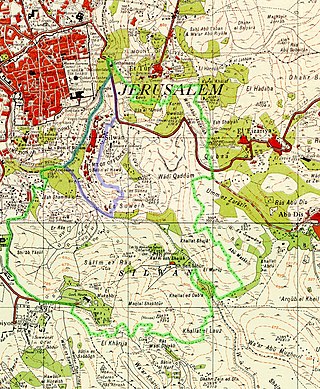
Wadi Hilweh is a neighborhood in the Palestinian Arab village of Silwan, intertwined with an Israeli settlement called the City of David. The neighborhood is called after a section of the central valley of ancient Jerusalem, which it straddles.

















